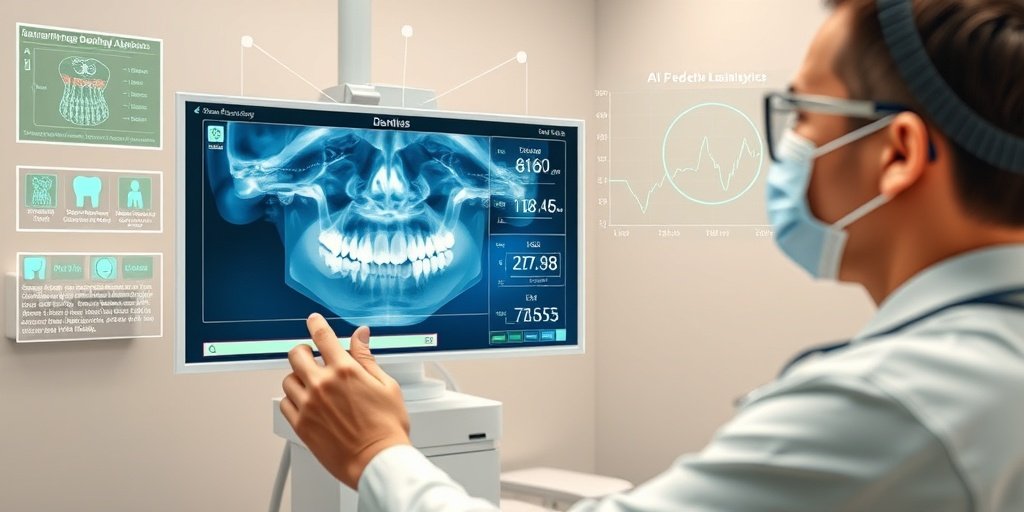⚡ Quick Summary
This study explored the integration of Demirjian’s method with machine learning algorithms to enhance the accuracy of dental age estimation in children and adolescents from southeastern Brazil. The results indicated that machine learning models, particularly Gradient Boosting and Random Forest, significantly reduced predictive errors, achieving an MAE of 0.75 years.
🔍 Key Details
- 📊 Dataset: 610 digital panoramic radiographs of children and adolescents
- 🧩 Features used: Developmental stages of permanent mandibular teeth
- ⚙️ Technology: Eight machine learning models including Linear Regression, Gradient Boosting, and Random Forest
- 🏆 Performance: Gradient Boosting: MAE 0.75, RMSE 0.92
🔑 Key Takeaways
- 📊 Machine learning can significantly improve the accuracy of dental age estimation.
- 💡 The integration of AI with traditional methods enhances reliability and reduces errors.
- 👩🔬 The study utilized a large dataset of 610 radiographs for robust analysis.
- 🏆 Gradient Boosting and Random Forest models outperformed Demirjian’s method.
- 📉 Achieved a 44.03% reduction in MAE compared to traditional methods.
- 🌍 Findings are applicable in both clinical and forensic settings.
- 🔍 Bootstrapping was used to calculate 95% confidence intervals for accuracy metrics.

📚 Background
Accurate dental age estimation is crucial in various fields, including pediatric dentistry, forensic science, and orthodontics. Traditional methods, such as Demirjian’s, rely on visual assessment of dental development stages, which can be subjective and less precise. The advent of machine learning offers a promising avenue to enhance these estimations, providing a more objective and reliable approach.
🗒️ Study
Conducted in southeastern Brazil, this retrospective study analyzed 610 digital panoramic radiographs of children and adolescents. The researchers applied Demirjian’s method to classify the developmental stages of permanent mandibular teeth into eight categories. Subsequently, they trained and evaluated eight different machine learning models using five-fold cross-validation to predict chronological age based on these stages.
📈 Results
The study found that machine learning models achieved predictive errors of less than 1.5 years. Notably, the Gradient Boosting model demonstrated the highest performance with an MAE of 0.75 years and an RMSE of 0.92 years. These results represent a significant improvement over Demirjian’s method, which had an MAE of 1.34 years and an RMSE of 1.63 years.
🌍 Impact and Implications
The integration of machine learning with traditional dental age estimation methods can revolutionize the field. By reducing errors and enhancing reliability, this approach not only optimizes diagnoses but also provides a more adaptable tool for diverse populations. The implications extend to clinical practice and forensic investigations, where precise age estimation is often critical.
🔮 Conclusion
This study highlights the transformative potential of machine learning in dental age estimation. By combining traditional methods with advanced algorithms, healthcare professionals can achieve more accurate and reliable assessments. As technology continues to evolve, further research in this area is encouraged to explore its full potential in various applications.
💬 Your comments
What are your thoughts on the integration of machine learning in dental age estimation? We would love to hear your insights! 💬 Leave your comments below or connect with us on social media:
Dental age estimation by comparing Demirjian’s method and machine learning in Southeast Brazilian youth.
Abstract
This study evaluated the applicability of combining Demirjian’s method with machine learning algorithms to estimate the chronological age of children and adolescents from southeastern Brazil, using dental development stages as predictive variables. A retrospective study was conducted using 610 digital panoramic radiographs of children and adolescents. Demirjian’s method was applied to classify the permanent mandibular teeth into eight developmental stages. Eight machine learning models-Linear Regression, Gradient Boosting Regressor, K-Nearest Neighbors Regressor, Support Vector Regression, Multilayer Perceptron Regressor, Decision Tree Regressor, Random Forest Regressor, and AdaBoost Regressor-were trained and evaluated using five-fold cross-validation. Model accuracy was compared to the traditional method using Mean Absolute Error (MAE), Root Mean Squared Error (RMSE), and the Coefficient of Determination (R²). Paired Student’s t-tests were used to compare actual chronological age with predicted age estimates, and bootstrapping with 1,000 iterations was performed to calculate 95% confidence intervals (CI95%). Machine learning-based models achieved predictive errors of less than 1.5 years. The Gradient Boosting and Random Forest models demonstrated the highest performance, with an MAE of 0.75 (95% CI: [0.66-0.85]) and an RMSE of 0.92 (95% CI: [0.81-1.05]), representing a 44.03% reduction in MAE and a 43.56% reduction in RMSE compared to Demirjian’s method (MAE = 1.34, RMSE = 1.63). Integrating machine learning with Demirjian’s method improved the accuracy of dental age estimation, reducing errors and enhancing the reliability of the approach. The application of artificial intelligence reduces the mean absolute error of the dental age estimation method. This approach can optimize diagnoses and assist in both clinical and forensic settings, providing a more precise and adaptable tool for diverse populations.
Author: [‘Abuabara A’, ‘do Nascimento TVPM’, ‘da Cruz KR’, ‘Küchler EC’, ‘Madalena IR’, ‘de Oliveira MBCR’, ‘Lepri CP’, ‘de Menezes-Oliveira MAH’, ‘de Araujo CM’, ‘Baratto-Filho F’]
Journal: Forensic Sci Med Pathol
Citation: Abuabara A, et al. Dental age estimation by comparing Demirjian’s method and machine learning in Southeast Brazilian youth. Dental age estimation by comparing Demirjian’s method and machine learning in Southeast Brazilian youth. 2025; (unknown volume):(unknown pages). doi: 10.1007/s12024-025-01042-3